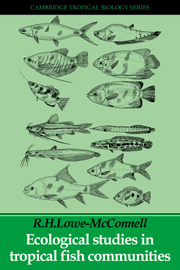Book contents
- Frontmatter
- Contents
- Preface
- Acknowledgements
- PART I INTRODUCTION
- PART II FRESHWATER STUDIES
- 2 The African fish fauna
- 3 Man-made lakes
- 4 Lacustrine fish communities in the Great Lakes of eastern Africa
- 5 Speciation: the African Great Lakes as laboratories of evolution
- 6 The Neotropical fish fauna
- 7 Far Eastern freshwater fish faunas and their distributions
- PART III MARINE FISH STUDIES
- PART IV SYNTHESES
- Appendix: Fish families in tropical waters
- References
- Index
- Frontmatter
- Contents
- Preface
- Acknowledgements
- PART I INTRODUCTION
- PART II FRESHWATER STUDIES
- 2 The African fish fauna
- 3 Man-made lakes
- 4 Lacustrine fish communities in the Great Lakes of eastern Africa
- 5 Speciation: the African Great Lakes as laboratories of evolution
- 6 The Neotropical fish fauna
- 7 Far Eastern freshwater fish faunas and their distributions
- PART III MARINE FISH STUDIES
- PART IV SYNTHESES
- Appendix: Fish families in tropical waters
- References
- Index
Summary
Lake Chad provided an example of a natural lake in which many of the fish were under the influence of the inflowing rivers, and there was little distinction between riverine and lacustrine fish communities. The creation of a man–made lake behind a hydroelectric or irrigation barrage provides a large–scale experiment on how riverine species become adapted for lacustrine life, how faunas change and how lacustrine communities evolve. In the sudanian area, pre– and postimpoundment studies were made at Kainji, in Nigeria, where a hydroelectric barrage across the Niger, closed in 1968, led to the formation of a 1280 km2 lake with an outflow:storage ratio of 4:1 and a large (10 cm) annual drawdown. Prior to this, the closure of the Volta Dam in Ghana in 1964 had created an 8800 km2 lake, one of the world's largest man–made lakes; here the storage volume was four times that of the outflow and the drawdown only 3 m annually, providing more truly lacustrine conditions. Both lakes were populated with the same species of sudanian fishes from their inflowing rivers, the Niger and Volta, respectively. Lake Nasser/Nubia on the Nile, which formed behind the Aswan Dam closed in 1964, also has many of the same species of fish (Ali, 1984; Latif, 1984), as does Lake Kossou on the Bandama River in the Ivory Coast, formed more recently (Daget, Planquette & Planquette, 1973).
- Type
- Chapter
- Information
- Ecological Studies in Tropical Fish Communities , pp. 63 - 72Publisher: Cambridge University PressPrint publication year: 1987



